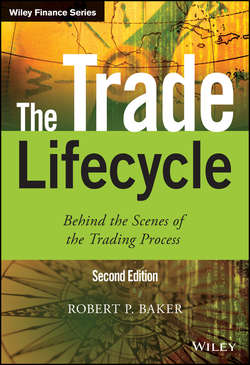Читать книгу The Trade Lifecycle - Baker Robert P. - Страница 30
На сайте Литреса книга снята с продажи.
Part One
Products and the Background to Trading
Chapter 3
Understanding Traded Products – Follow the Money
3.8 Bond spot
ОглавлениеFor a fuller description of bonds, see section 4.4. As for equity, we need to distinguish from whom we are buying the bond.
If we buy it from someone other than the issuer, it is a standard spot trade. We receive a bond and can redeem the coupons on the bond for cash from the issuer (but not from the counterparty).
We are therefore going to examine the cashflows when we purchase a bond directly from the issuer. The various parameters of a bond which determine the time and size of its cashflows are set by the issuer at the time of issuance. It is possible to create a huge variety of different bonds by varying these parameters, but there are some characteristics common to all bonds. If we purchase a bond, we give up some cash (the purchase price) and receive a financial instrument that obliges the issuer to pay us cash (by redemption of a coupon) at a time or various times in the future. Bonds have a:
■ notional amount – this is used to determine the size of each coupon
■ schedule of coupon dates
■ redemption – this is the final cash amount we receive (aside from any coupons) at the maturity of the bond.
We have restricted the illustration of cashflows to three common types: a fixed coupon bond (Figure 3.10), a floater (Figure 3.11), and a zero coupon bond (Figure 3.12).
Figure 3.10 Cashflows on fixed bond
Figure 3.11 Cashflows on floating bond
Figure 3.12 Cashflows on zero coupon bond
Perhaps the simplest type of bond is one that pays fixed coupons. Here all the cashflows are known at the outset of the trade. We give the issuer the purchase price at the start of the trade and they pay fixed coupons at periodic intervals until the bond reaches maturity. At that time, they pay the last, fixed coupon plus the redemption amount which is set at 100 by convention.
A floating coupon bond (also known as a floater) pays a coupon based on a reference entity. The coupon is fixed just prior to the due date in the same manner as swap fixings described above. Hence we know the time when coupons will be due, but we do not know the amounts until just before payment.
A zero coupon bond pays no coupons. We pay the purchase price at the start and receive the redemption at the end so there are just two, fixed cashflows.
